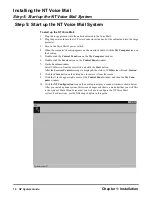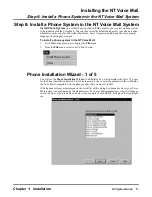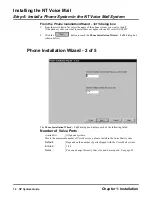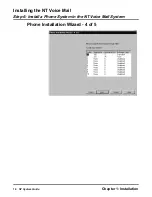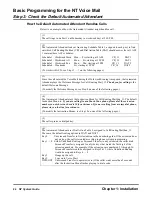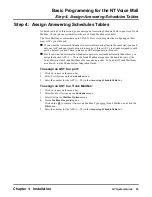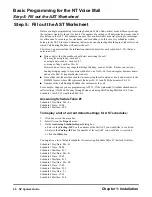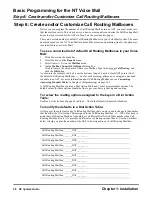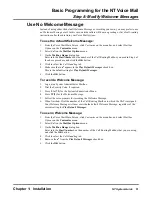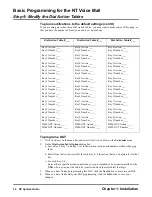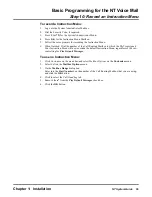
Basic Programming for the NT Voice Mail
Step 3: Check the Default Automated Attendant
24
NT System Guide
Chapter 1: Installation
How the Default Automated Attendant Handles Calls
Below is an example of how the Automated Attendant might handle a call.
(1)
The call rings in on Port 1 on Wednesday (a workweek day) at 5:30 PM.
(2)
The Automated Attendant looks at Answering Schedule Table 1, assigned to each port, to find
out which Call Routing Mailbox (CR) and Dial Action Table (DAT) should answer the call. AST
1 contains these AST schedules:
Schedule 1: Workweek Morn Mon — Fri, starting at 9 AM CR_11 DAT 1
Schedule 2: Workweek Aft Mon — Fri, starting at 12 PM CR_12 DAT 1
Schedule 3: Workweek Eve Mon — Thu, starting at 5 PM CR_13 DAT 2
Schedule 4: Weekends Fri, starting at 5 PM CR_14 DAT 2
(To work with ASTs, see Steps 5 — 7 on the following pages.)
(3)
Since the call entered the Voice Mail during the Workweek Evening time period, the Automated
Attendant plays the Welcome Message for Call Routing Mail_13. Thank you for calling is the
default Welcome Message.
(To modify the Welcome Messages, see Step 8 on one of the following pages.)
(4)
The Automated Attendant plays the Instruction Menu for Call Routing Mailbox_13. The default
Instruction Menu is: If you are calling from a Touch Tone phone, please dial the extension
number you wish to reach or dial 0 for assistance. If you are calling from a rotary dial phone,
please stay on the line for assistance.
(To modify the Instruction Menus, see Step 10 on one of the following pages.)
(5)
The caller presses a dialpad key.
(6)
The Automated Attendant uses Dial Action Table 2, assigned to Call Routing Mailbox_13.
These are the default routing options in DAT1 and DAT 2:
Key 0 Unscreened Transfer to first extension in the numbering plan. If the extension does
not pick up, the call is rerouted according to phone system programming.
Key 1— 8 Either Undefined Routing or Screened Transfer to any extension the caller dials.
Screened Transfer is assigned to only the keys that match the first digit of the
extension numbers. For example, if the extensions are numbered 21 through 36,
Screened Transfer would be assigned to Keys 2 & 3, while Undefined Routing
would be assigned to Keys 4 — 8.
Key 9 Hangs up the call.
Key # Logs on to Voice Mail
TIMEOUT Unscreened Transfer to operator (zero) if the caller waits more than 5 seconds
after the Instruction Menu finshes playing to dial a code.
Summary of Contents for NVM-NT
Page 28: ...Table of Contents Chapter 5 Maintenance xxvi NT System Guide ...
Page 130: ...Installing SMDI 102 NT System Guide Chapter 3 Programming ...
Page 146: ...Customizing Caller I D Tables General Tab 118 NT System Guide Chapter 3 Programming ...
Page 156: ...Customizing Callout Options Optional Tab 128 NT System Guide Chapter 3 Programming ...
Page 182: ...Customizing Distribution Lists General Tab 154 NT System Guide Chapter 3 Programming ...
Page 338: ...Customizing Port Options General Tab 310 NT System Guide Chapter 3 Programming ...
Page 358: ...Customizing System Options Timers Tab 330 NT System Guide Chapter 3 Programming ...
Page 362: ...Customizing System Options Timers Tab 334 NT System Guide Chapter 3 Programming ...
Page 367: ...Customizing Tenant Options General Tab Chapter 3 Programming NT System Guide 339 ...
Page 396: ...Viewing and Printing Reports System Options Report 368 NT System Guide Chapter 3 Programming ...
Page 400: ...Performing a Local Backup Backup Dialog Box 372 NT System Guide Chapter 3 Programming ...
Page 440: ...Using Port Activities 412 NT System Guide Chapter 3 Programming ...
Page 454: ...Using Message Status Message Status Dialog Box 426 NT System Guide Chapter 3 Programming ...

